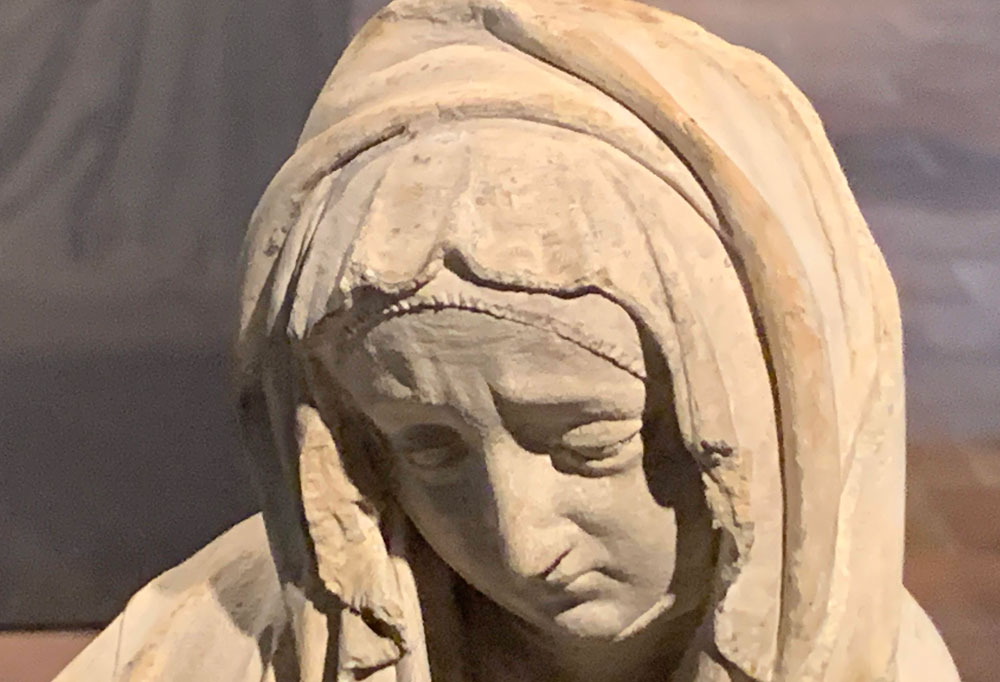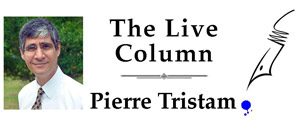
Twice in the past few weeks the Supreme Court declared unconstitutional attendance limits imposed on houses of worship during the coronavirus pandemic. The court reversed its own order finding those limits constitutional just weeks ago. The difference was one vote. Ruth Bader Ginsburg is dead. Amy Barrett is not. Donald Trump’s third appointment to the court is reviving the religious right’s dreams of a theocracy.
 That may well happen, and the vote alignment of the five most conservative justices on the side of letting houses of worship rip during the pandemic certainly suggests a nightmare alignment for liberals. But those decisions aren’t the time to fret. To the contrary. The Nov. 25 decision by conservatives is one of the most liberal First Amendment rulings in a long time.
That may well happen, and the vote alignment of the five most conservative justices on the side of letting houses of worship rip during the pandemic certainly suggests a nightmare alignment for liberals. But those decisions aren’t the time to fret. To the contrary. The Nov. 25 decision by conservatives is one of the most liberal First Amendment rulings in a long time.
A Catholic church and a synagogue had filed suit to protest Gov. Andrew Cuomo’s limit of 10 worshippers at services, or 25 in slightly more permissive conditions. Both houses of worship had ample room to allow for many more people, with social distancing. Both houses had followed the rules, both had exemplary records through the pandemic, without apparent infections that could be traced to their services. Nevertheless they were shut down. By the time the lawsuit reached the court, Cuomo had lifted the limits.
The liberals on the court, joined by Chief Justice John Roberts, who’s been drifting left since the court started bowing to John Birch, argued that should have been enough for the court not to take the case. They didn’t have it wrong. The court only on the rarest occasions takes up emergency orders. Those should be kept to clear and present emergencies. The houses of worship’s case no longer was. But the conservatives didn’t have it wrong, either. They chose to make a statement. Their statement was necessary and decisive. In the words of Justice Neil Gorsuch for the majority, “cutting the Constitution loose during the pandemic” is not admissible, because “Government is not free to disregard the First Amendment in times of crisis.”
That kind of language recalls great First Amendment decisions of the past, such as that of Justice Robert Jackson in 1943, upholding the right of students not to salute the flag or recite the Pledge of Allegiance even in time of war, or that of Abe Fortas in 1972 declaring in the midst of violent protests over the Vietnam war that students do not “shed their constitutional rights to freedom of speech or expression at the schoolhouse gate.” (That 1972 decision was overturned, unfortunately, by a 5-4 majority led by Roberts in the 2007 “Bong Hits 4 Jesus” case, extending school authority over student speech beyond the schoolhouse door.)
There is no greater responsibility for government than to protect the health and safety of its citizens. Governments should have plenty of latitude enacting pandemic rules, from mask-wearing to limits on gatherings. But the rules must make sense, and they must apply fairly. The rules that elicited the cases from New York churches and synagogues did not. It made no sense to impose a limit of 10 or 25 people in a congregation where there was enough space for hundreds, where social distancing was possible, and where the same rules did not apply to liquor stores, bike shops or acupuncturists.
Those businesses were declared essential, while houses of worship were deemed inessential. We can have an interesting argument about that, and philosophers and theologians have been going at it since the caves of Lascaux were used to worship bulls a dozen millennia ago. But it’s not up to government to arbitrate. The First Amendment doesn’t single out liquor stores or grocery stores for protection from government. It does single out religious expression, just as it does the press, just as it does the right to speech and assembly.
Imagine for a moment if government were to prohibit the publication of certain opinions. There’s certainly an immense amount of false and dangerous information out there about the pandemic. Platforms like Facebook, Twitter, newspapers and even FlaglerLive have every reason to prevent it from seeing the light of day. We do that every day. But what if government were to actually prohibit it on public health grounds? It could make that argument, and would have more reasons to do so than to limit the number of worshippers in a church. The wrong kind of information in this pandemic–masks are pointless, children have nothing to worry about, Covid is a hoax–isn’t just an opinion. Its dissemination can, and demonstrably has, helped pile up the body count, and continues to do so. It’s still not government’s business to regulate that sort of speech, though it must be the business of every responsible media platform.
The same argument can be made about protests, like last summer’s protests against police brutality. The protests and others like them have not been a major contributor to the epidemic. But they weren’t infection-free zones, either, especially when large groups of people were arrested, herded together and jailed. The protesters did pose a public health danger. But again, it would have been scandalously unconstitutional for any government at any level to attempt a protest ban.
For doubters that large public gatherings outside can be dangerous: one of the greatest superspreader events of the 1918 flu pandemic was a bombastic patriotic parade in Philadelphia, to flame-broil fevers for more massacres in Europe. It did the job, but the massacre that followed was in Philadelphia, by the flu: Philadelphia would lose 16,000 people in the next six months. The difference is that the parade was entirely unnecessary, preventable, permitted and promoted by the mayor, who’d been counseled against it by innumerable people. Last summer’s protests were answering to a higher, essential calling: state-sponsored brutality should not be countenanced under any circumstances, pandemics included. And protesters were for the most part masked, distanced and aware of pandemic precautions. Philadelphians of 1918 were not as informed.
Bottom line: if government were to silence protests, the size of protests would grow tenfold, and most of us would join in. Why not apply the same principle to houses of worship, where attendance is voluntary?
So the court’s decision was a decisive victory for the First Amendment. The entire First Amendment. It has nothing to do with Ginsburg versus Barrett, church or state or even any perceived hierarchy between speech, religion and free expression. It has to do with constitutional rights, whether we’re at peace, at war, in a pandemic or in a twilight zone. Liberals will be thankful for it one day. Some of us already are.
![]()
Pierre Tristam is FlaglerLive’s editor. Reach him by email here. A version of this piece aired on WNZF.





























ASF says
Funny how Hasidic Jews were raked over the coals and attacked (sometimes physically) for what the Catholic Church is now defending their own right to do. Just sayin’…
Denali says
The very idea of treating places of worship as a ‘special case’ was off-base from the beginning.
Please bear with me here – The building and fire codes in our country group building uses into Occupancy Classifications. While there are several occupancy types, the one in question here would be the Group A, Assembly Occupancy – it is just as it sounds, a place where people gather, or assemble. Typical uses include large meeting rooms, large restaurants and bars, rail & airport terminals, lecture halls, school gymnasiums with seating, theaters (live & movie) and of course, places of worship. With the exception of bars, the life/safety requirements for each of these uses are almost identical; bars have more stringent sprinkler requirements. What I am trying to demonstrate here is that there is no difference between a movie theater and an indoor place of worship. Therefore, the only justifiable way we could impose a limit on the number of occupants in a place of worship is to impose the same limit on a theater.
That said, if we are going to close theaters for the pandemic, we should also close places of worship. Failure to do so would subject the occupants to an undue risk of exposure. While the First Amendment grants the freedom of worship, it does not grant the freedom to place others at risk during a health emergency. This has nothing to do with the separation of church and state, it is a simple matter of public health. I do have personal religious beliefs but they do not include my ‘god’ protecting me from my own stupidity by not following the medical guidelines. ‘He’ put those doctors and scientists here to lead me to safety.
Now, if someone wants to impose an arbitrary limit on the number of persons allowed in a place of worship only based solely on the fact that it is a place of worship, that action would be untenable. Or to put it another way, limiting the number or percentage of people in all assembly type buildings to the same ratio would be reasonable, to limit the number based on the building being a church to a lesser number than a movie theater would be wrong.
William Moya says
You nailed it.
Justsayin says
Should Walmart, Publix ,Home Depot and other large box stores be held to the same standards you speak about?
Justsayin says
Wow, for once I agree with much of what you said. I hope you will defend all the amendments the same way.
Pogo says
@Swiftly, some modest proposals
Firstly, I’ll have a glass of whatever it is that Denali drinks.
For others – some suggested reading: https://www.google.com/search?d&q=just+saying
And finally, give this some thought: https://www.google.com/search?d&q=church+software
Swimming is not a sport. Swimming is a way to keep from drowning. That’s just common sense!
— George Denis Patrick Carlin (May 12, 1937 – June 22, 2008)
wow says
Guess the Christians forgot that part about “wherever 2 or more are gathered”. No one is stopping them from meeting online. That’s just stupidity to insist on gathering in a group.
Camelot says
Your scripture reference is out of context.